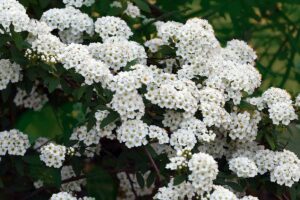One of the greatest threats to an evergreen’s ever-greenness is winter, and all the harsh, damaging conditions that come with it.
An evergreen shrub that doesn’t keep its verdant hue year-round is disappointing, whether the plant in question is a conifer or a broadleaf plant like boxwood, holly, or rhododendron.
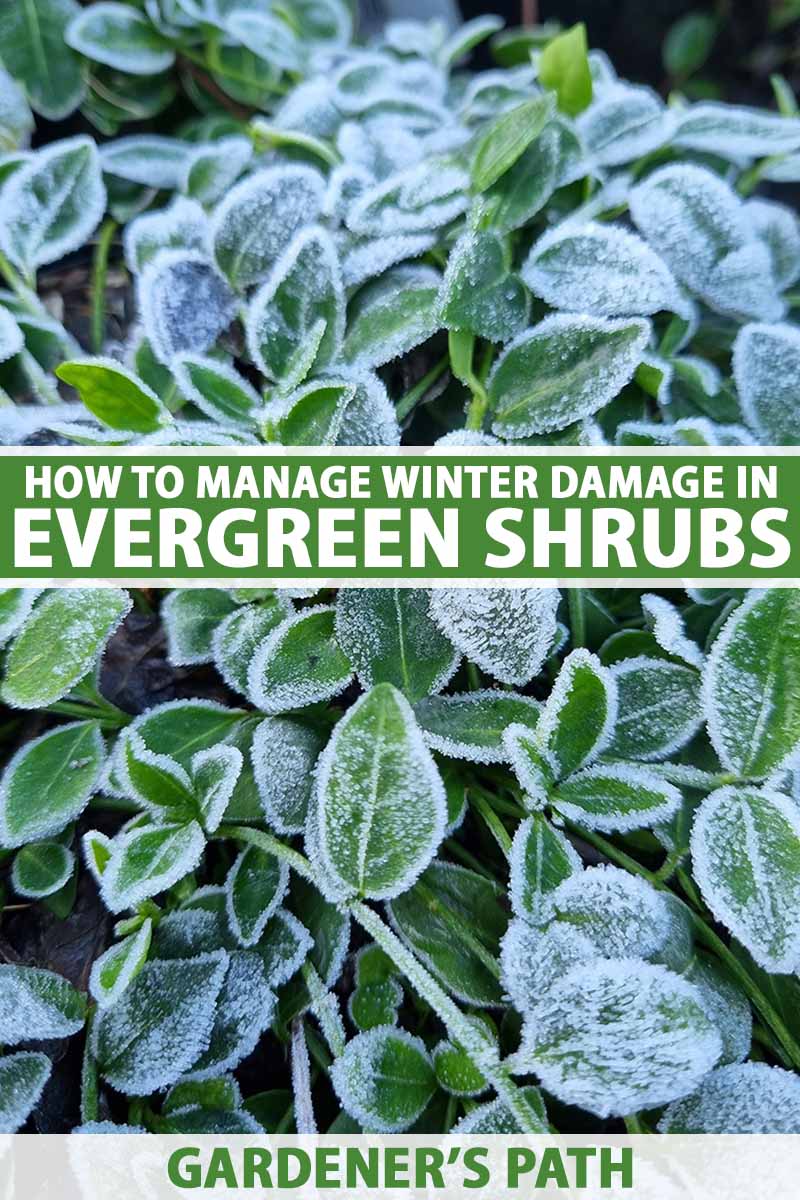
We link to vendors to help you find relevant products. If you buy from one of our links, we may earn a commission.
A rough winter can make it difficult for evergreen shrubs to maintain their lush, healthy appearance.
That’s where the knowledge, skill, and foresight of a well-trained gardener can make all the difference.
“But I’m not trained!” you may protest. Not yet, you’re not. But after reading this guide to managing and preventing winter damage in evergreen shrubs, you will be.
Your training begins now:
Managing Winter Damage in Evergreen Shrubs
Since winters tend to be harsh and chaotic – especially here in the Midwest – don’t be surprised if your evergreens experience more than one of the following types of damage simultaneously.
Cold Temperature Injury
First and foremost, an evergreen that lacks the hardiness necessary to thrive in its local climate will probably suffer cold injury.
A common boxwood, for instance, won’t fare well if you place it in USDA Hardiness Zone 3.
The fluid within its foliage will freeze and expand at temperatures below what the shrub can tolerate, rupturing cell walls. And floral and vegetative buds are often even more susceptible to cold injury than the leaves are.
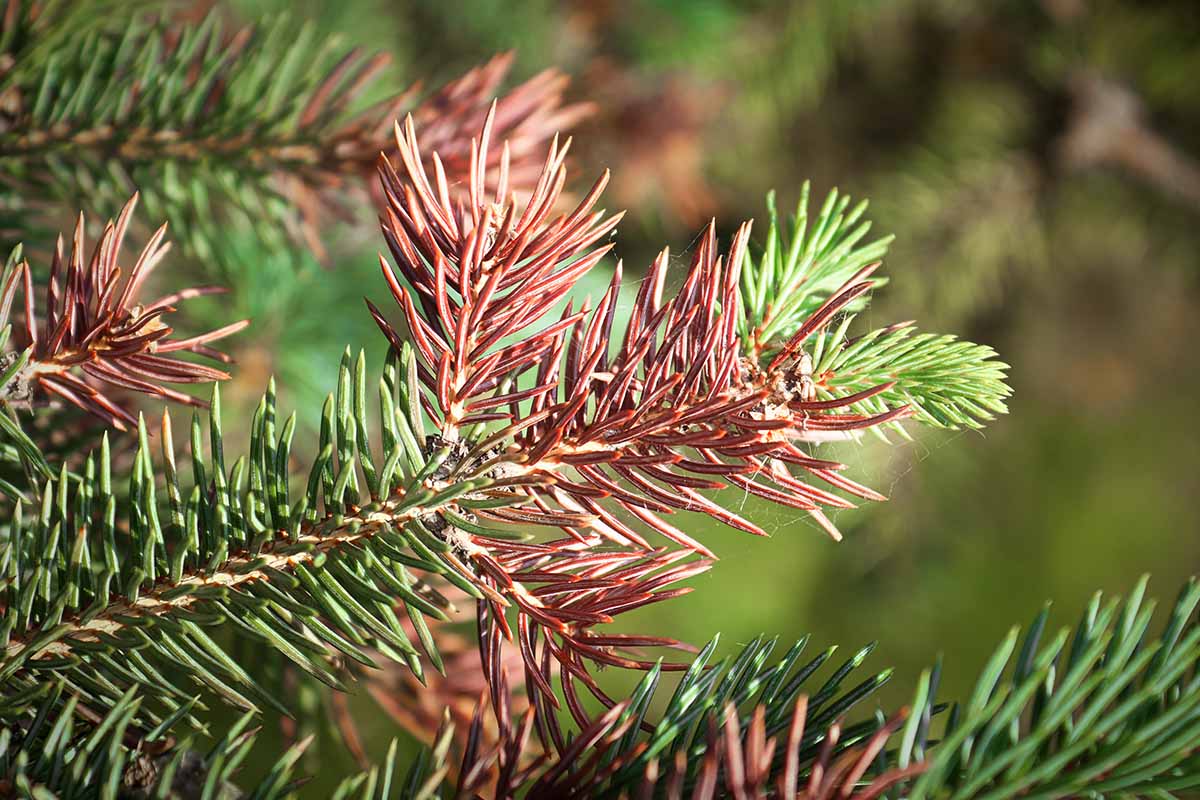
This cellular damage will leave tissues wilted, warped, and/or blackened.
New growth becomes limp, watersoaked, and withered, while evergreen shoots in particular bend downwards and exhibit red or brown discoloration a week or two after injury.
Belowground roots aren’t immune to cold injury, either.
Soil is typically warmer than air and slower to cool, and roots are actually less hardy than aboveground shoots. Add root system shallowness, an absence of insulation, and extreme cold to the mix, and root injury or death can easily occur.
Sometimes, it’s not even the exact degree of the chill that matters, but rather, the timing.
Evergreens will adapt to the stress of lowering temperatures come winter, provided the change is gradual. But an unusual bout of low temperatures in early fall can strike an evergreen shrub before it’s had time to acclimate to wintertime chills.
On the flip side, a late spring frost can harm that same plant after it’s lowered its defenses in anticipation of the coming warmth of the growing season.
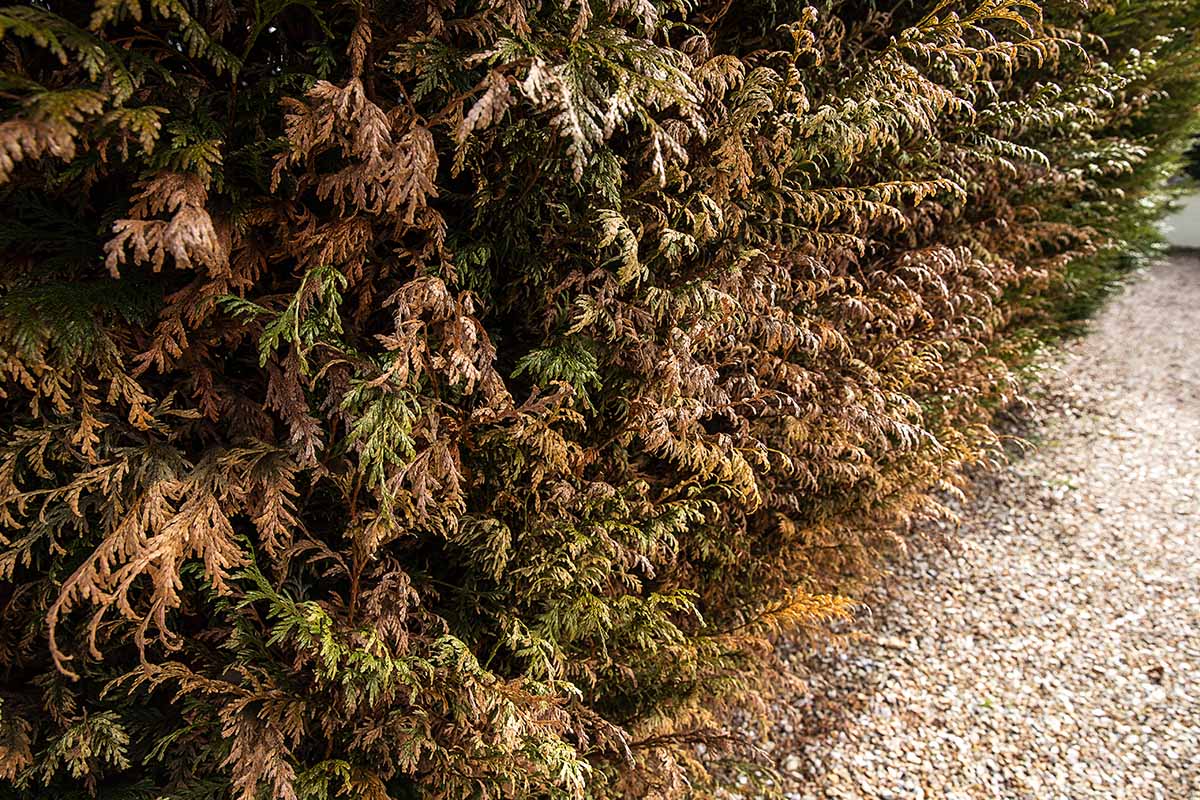
Throughout winter in many regions, temperatures also tend to jump up and down like a bad liar’s polygraph reading, going through repeated cycles of freezing and thawing.
This means your shrub is making constant attempts to keep up, trying to adapt in an ever-changing environment.
Temperatures can change quickly, and it’s easy for a burst of cold to catch a plant with its guard down.
When it comes to managing cold temperature injury, an ounce of prevention is worth a pound of cure – select evergreen shrubs that are suitably hardy for your region to begin with, and transplant them either before bud break in early spring, or prior to the onset of cold temperatures in late summer or fall.
Make sure to add three to four inches of mulch atop the root zone, as well.
If your shrubs are only marginally hardy for your area, be mindful of the microclimates formed in your garden.
Conditions such as heavy shade, harsh winds, and low elevations can lower the temperature beyond what a hardiness zone map indicates, and may put your specimens at risk.
Alternatively, utilizing protected areas such as courtyards or planting near walls can help shield your shrubs from harsh exposures.
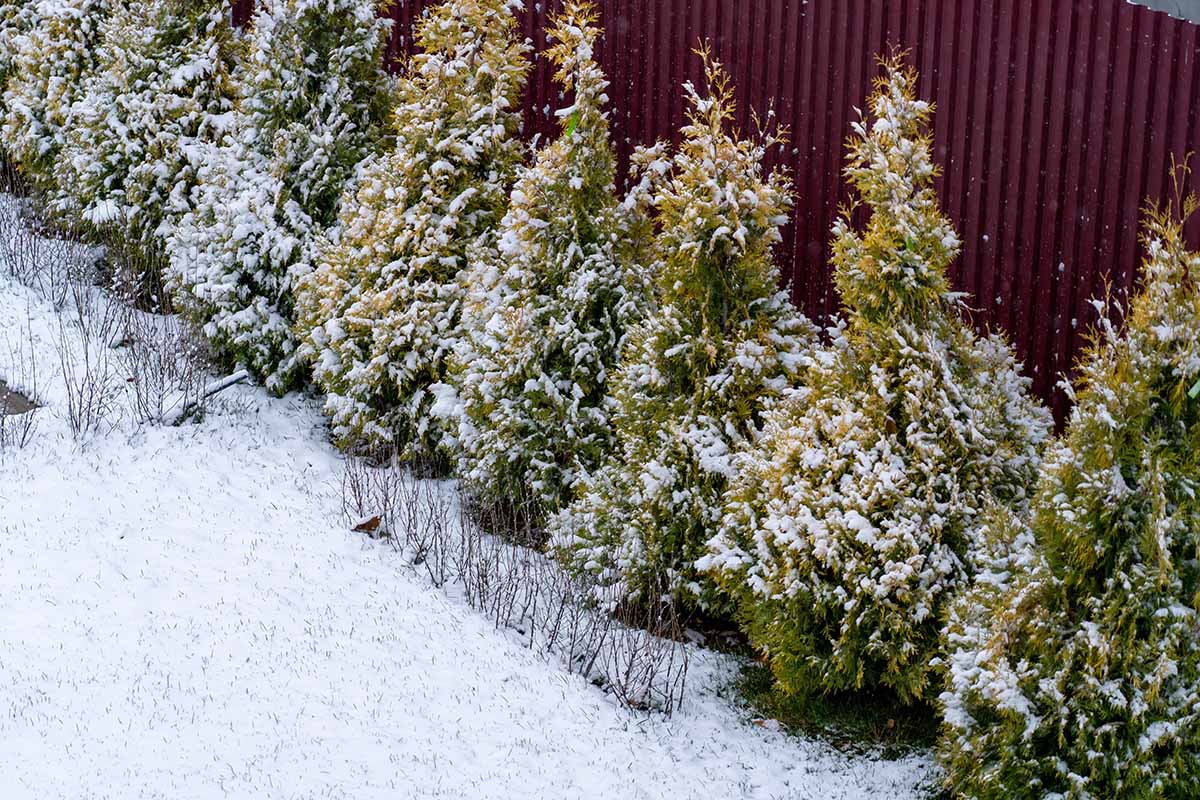
Avoid pruning too early or fertilizing too late, since both can lead to cold injury.
Premature pruning before the last frost in spring will leave the cut ends vulnerable, while belated fertilization in late summer or fall will kickstart new growth that won’t have time to harden off.
But suppose all that prep doesn’t go according to plan and your plantings are in jeopardy. Now what?
Container plants can be moved indoors or into a greenhouse when temperatures drop too low, while in-ground plantings can be covered with a thermal plant blanket.

If you’re looking for a lightweight, durable blanket with built-in grommets around the edge for easy staking, try the Planket, available from Amazon.
If you think injury has occurred in a branch, check for damage in spring by scraping a bit of surface bark away. Green tissue beneath indicates life, while browned necrosis indicates that the branch is dead.
Prune dead branches away with sterilized tools in spring, when the shrub starts to put out new growth.
Make your pruning cuts all the way back to the first living node, bud, or branch offshoot. The pruned areas should fill in with fresh growth within a couple of years, provided repeat cold injuries aren’t sustained in the same spots.
If you check an afflicted shrub in spring and find that it’s entirely brown and dead from top to crown, then it probably won’t recover.
If that’s the case, then it should be promptly removed and replaced with a hardier specimen. If you’re particularly attached to a specific species or cultivar, you may be able to place a similar specimen in a slightly warmer microclimate somewhere else in your landscape.
Winterburn
Winterburn is primarily related to a lack of water. Sunlight and wind strip away the plant’s moisture, while frozen soil hinders the uptake of water by the roots.
Poorly-developed, shallow root systems and low temperatures – especially following a warm and sunny day – can further exacerbate moisture problems.
Without enough water, desiccated leaves will appear brown, decayed, or even bleached.
In coniferous evergreens, discoloration first appears on the needle and scale tips, while broadleaf specimens will initially exhibit symptoms at the leaf edges.
It’s also worth noting that broadleaf evergreen leaves are typically more susceptible to winterburn than conifer foliage.
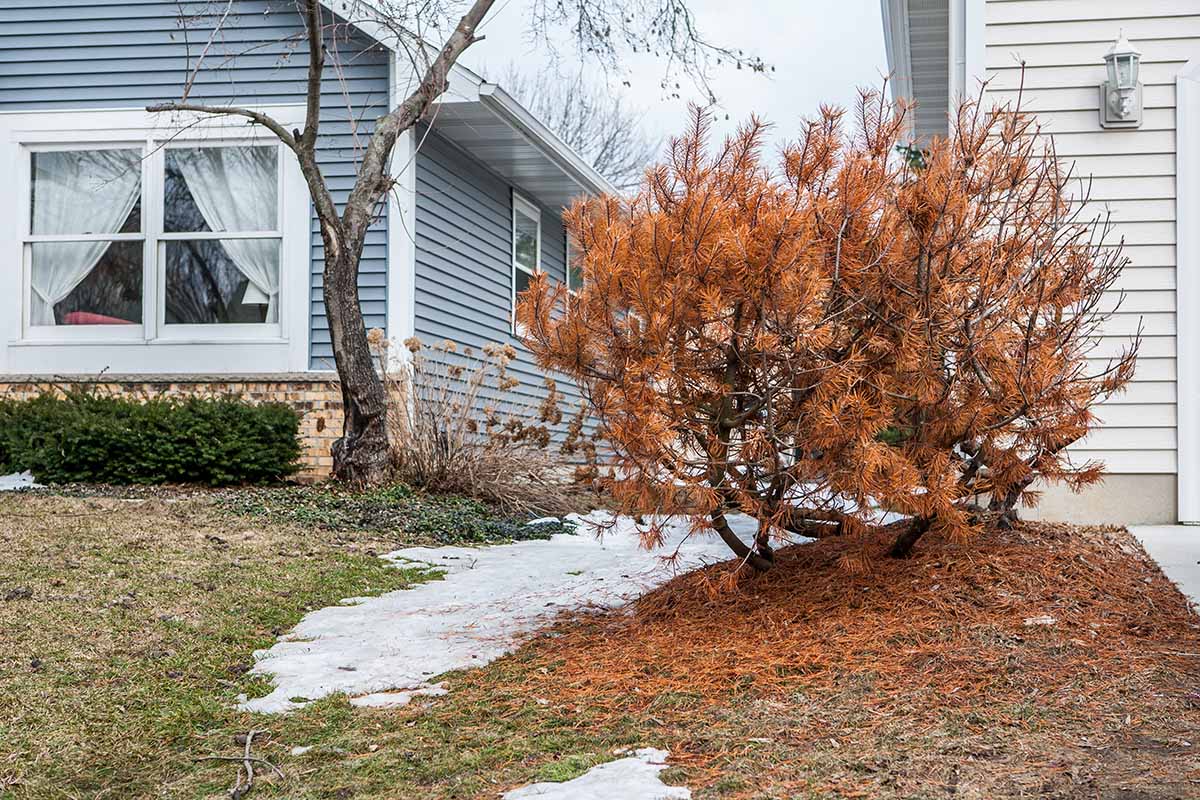
A holly leaf, for example, is a much larger target for wind and sunlight than a slender pine needle. Plus, winterburned broadleaf foliage is way more conspicuous.
As severity increases, winterburn can lead to leaf drop, discoloration throughout the plant, and tissue death. Severely afflicted plants may perish, in time.
Once a winterburn damaged shrub starts to exhibit new growth in spring, remove any damaged leaves, stems, and branches.
A visual examination should suffice, but feel free to use the same scrape test that you would for cold temperature injury to determine which portions of your shrub have died back.
Some winterburn risk factors are out of our hands, such as a warm autumn delaying the onset of dormancy. But many forms of winterburn prevention are well within our control.
The proper placement of suitable plants is paramount. Choose adequately hardy specimens, and place them in spots that are protected from excessive wind and sun exposure. Only transplant in early spring or late summer into fall.
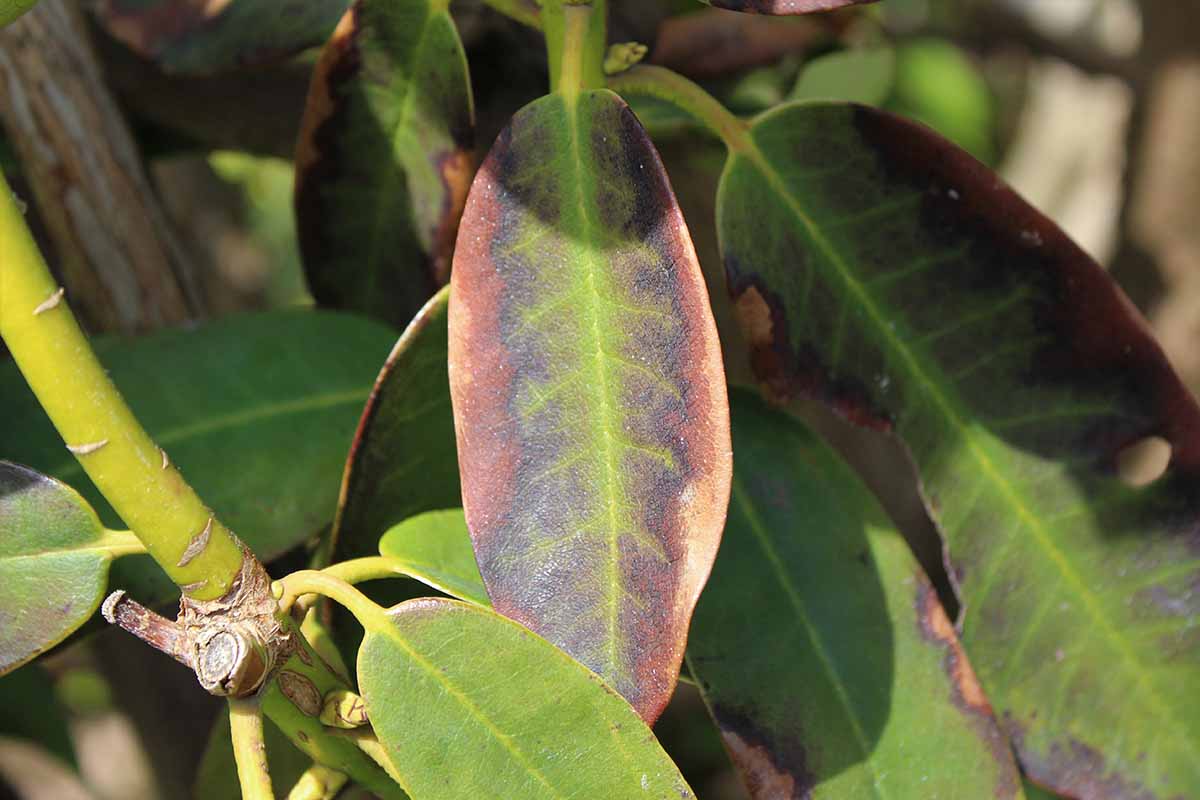
Pruning too early or fertilizing too late will also leave tissues vulnerable to winterburn.
A three- to four-inch layer of mulch will insulate the root zone and reduce water loss, while proper irrigation up until the soil freezes will top off the plant’s hydration levels for the winter.
If supplemental protection is needed, burlap or canvas screens can help to shield plants from harsh sun and wind. Use stakes at least four feet tall, and make sure the screens face the direction of prevailing winds.
Similar to those with cold temperature injury, any shrubs winterburned beyond repair should be removed after you’ve taken the time to give any still hanging on a chance to bounce back.
Replace them with tougher plantings, if you so desire, or choose future planting areas that are more protected.
Snow and Ice Breakage
I can empathize with evergreen shrubs somewhat, since we both tend to gain some unwanted wintertime weight.
But while my excess mass stems from peanut butter and indoor confinement, snow and ice buildup is what often weighs down these plants.

As the precipitation piles up, branches and stems can become bent out of shape, which is bad enough on its own.
When the weight increases beyond a certain threshold, those structures can break, rendering plants unattractive and vulnerable.
You can’t really remove ice buildup while temperatures remain below freezing, but snow can be brushed off as it accumulates on your evergreens.
During periods of intense snowfall, you may have to do so every four to five hours.
Depending on the height of the shrub, you may need some vertical assistance from a broom or lightweight snow shovel. As always, do not climb ladders to perform yard work in unsafe conditions.
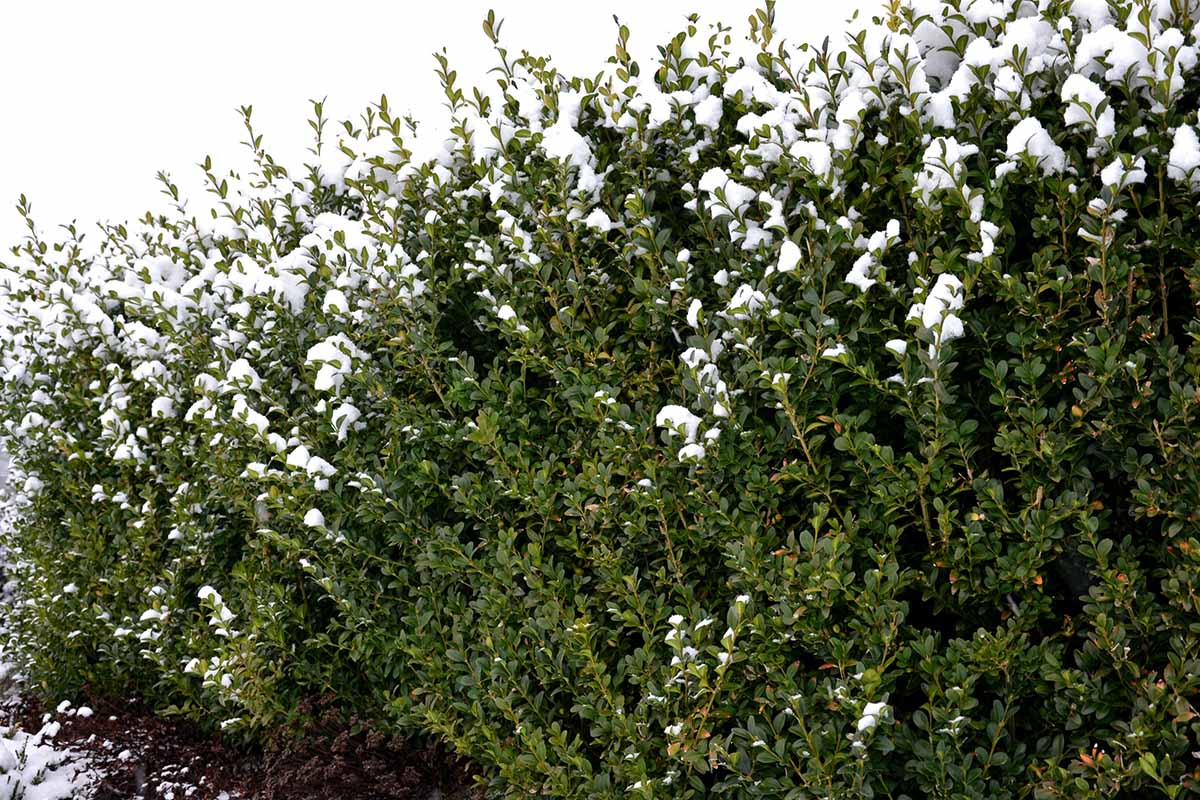
Unless you’re Storm from the X-Men, chances are you can’t control the weather… but you can prepare an evergreen shrub for snowfall and ice ahead of time.
In spring or summer, prune any weak or structurally unsound branches that might break in a blizzard.
After a snowy and icy winter, remove broken, hanging, and otherwise damaged branches in spring to keep your shrubs healthy and looking sharp.
If the damage is extensive, the aid of a professional arborist can be invaluable.
Herbivore Feeding Damage
Winter is often a lean time for many plant-munching mammals.
Once their preferred plants become scarce, herbivores such as deer and rabbits can turn to your evergreen shrubs for sustenance.
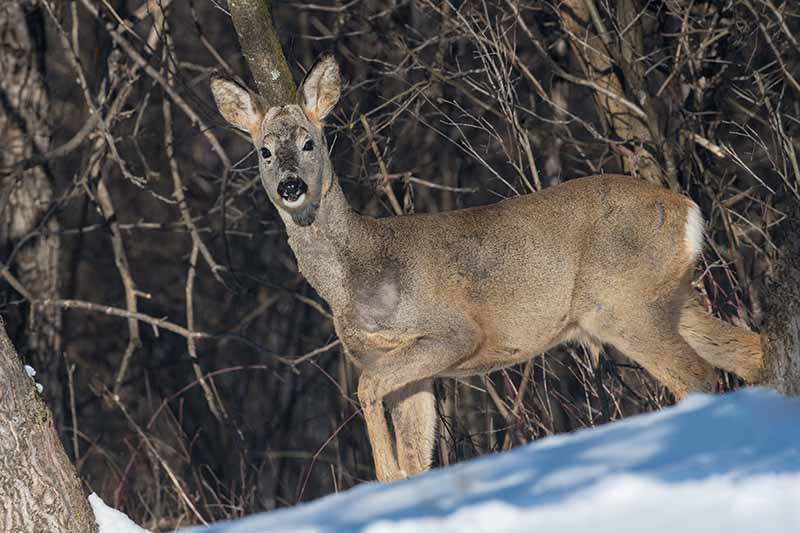
Tender young specimens are especially vulnerable, and severe “pruning” by the local wildlife may result in a failure to ever attain a symmetrical form as plants mature following a harsh feeding.
For prevention, some quality fencing can come in handy. A line of deer fencing around your property and individual rabbit fencing around specimens you want to protect can provide the ultimate one-two punch of security.
Liquid repellent can also be sprayed on or at-risk plants.
Only apply liquid products to dry foliage when temperatures are above freezing, and reapply according to package instructions, particularly after periods of heavy rain.
Liquid Fence sells gallon-sized containers of liquid deer and rabbit repellent that are available on Amazon.

If herbivores still end up eating your evergreens, you’ll have to wait until mid- to late spring to see the extent of the damage.
If munched-upon tissues still haven’t put out new growth, it’s best to cut them back to the first living, growing node.
Salt Injury
As soon as that first bout of winter ice glazes over the pavement, folks are quick to douse sidewalks and driveways with copious amounts of salt, namely sodium chloride.
And while that often saves pedestrians from breaking a hip, it may leave evergreen shrubs with injuries of their own.
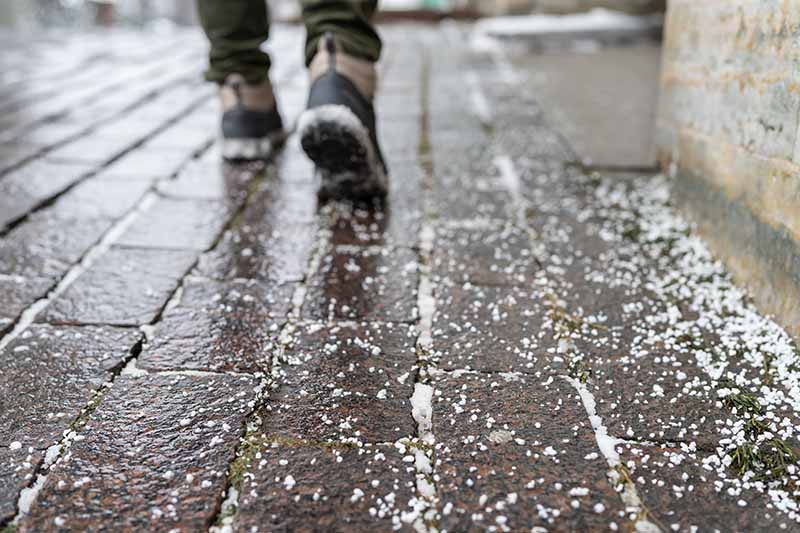
If rock salt lands in the root zone, it can prevent a plant from absorbing water. If the concentration is high enough, uptake of other essential minerals from the soil may be impaired.
Together, these problems cause spring and summer symptoms such as desiccation, foliar browning, and root damage.
Additionally, if salt is sprayed onto a shrub it can kill twigs, branches, and foliage.
All the more reason to be careful when applying salt: do so conservatively, and do your best to control where the salt actually ends up.
Instead of using standard sodium chloride, you could improve traction with coarse sand or de-icing products that are safer for plants, such as calcium chloride or calcium magnesium acetate.

Green Gobbler Calcium Chloride
Green Gobbler sells 45-pound pails of fast-acting calcium chloride that are available on Amazon.

Natural Alternative Calcium-Magnesium Acetate
Alternatively, you can purchase concrete-safe calcium magnesium acetate from Natural Alternative, available in 30-pound bags on Amazon.
The type of burlap barrier mentioned earlier to block sun and wind can come in handy as a salt shield as well, especially for evergreens growing alongside public roadways where municipal salt application is unavoidable.
Many other materials work for shielding, too: plastic, plywood, or even window screening!
For any specimens afflicted with excess salt exposure, deep watering in spring can help to flush what remains from the soil. Damaged areas may be pruned at this time as well.
If you’re looking for less salt-susceptible plantings, check out our roundup of salt-tolerant evergreen shrubs!
Improper Holiday Lighting
Granted, this is the least concerning threat on the list.
But wouldn’t it sting if you’ve defended against the other winter dangers described here properly, only to hurt your evergreen shrubs with a misguided attempt at holiday cheer?
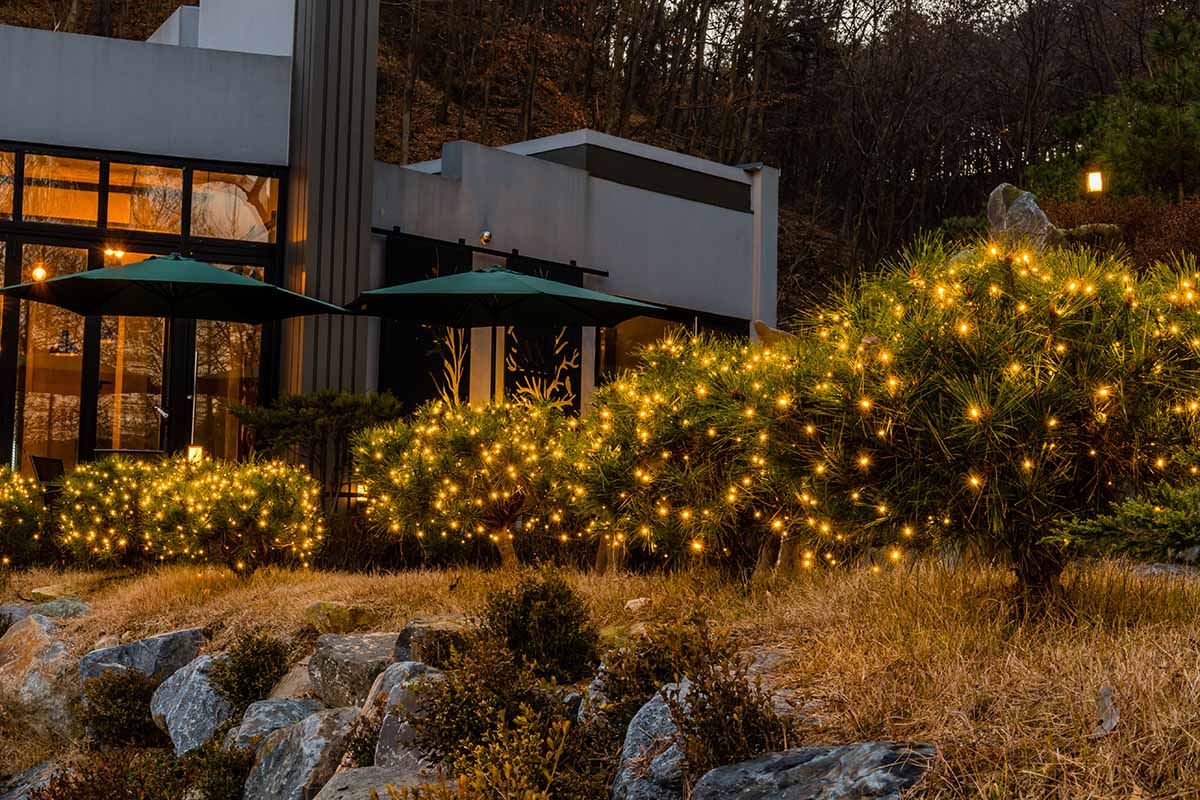
First, make sure your holiday illuminations are cleared for the outdoors, not designated for indoor use only.
Strings of indoor-only electric lights, while safe to use with plastic Christmas trees, could possibly burn or otherwise damage your living shrubs. Any branches that have been harmed can be pruned after the last spring frost.
Got the right lights? Ensure that they have no frayed wires or loose connections, both of which could cause an electrical fire.
Additionally, utilize extension cords and lightboxes which are resilient against the elements – these must be rated for outdoor use as well.
Finally, be mindful about how you actually put the lights up.
You shouldn’t choke out your plantings via tightly-wrapped lights, and juvenile specimens should not be draped with heavy lights that might snap young branches. Wait for them to mature a bit first.
Winter Is Coming…
Whether winter is just around the corner or several seasons away, it pays to “be prepared,” as the Boy Scouts are fond of saying.
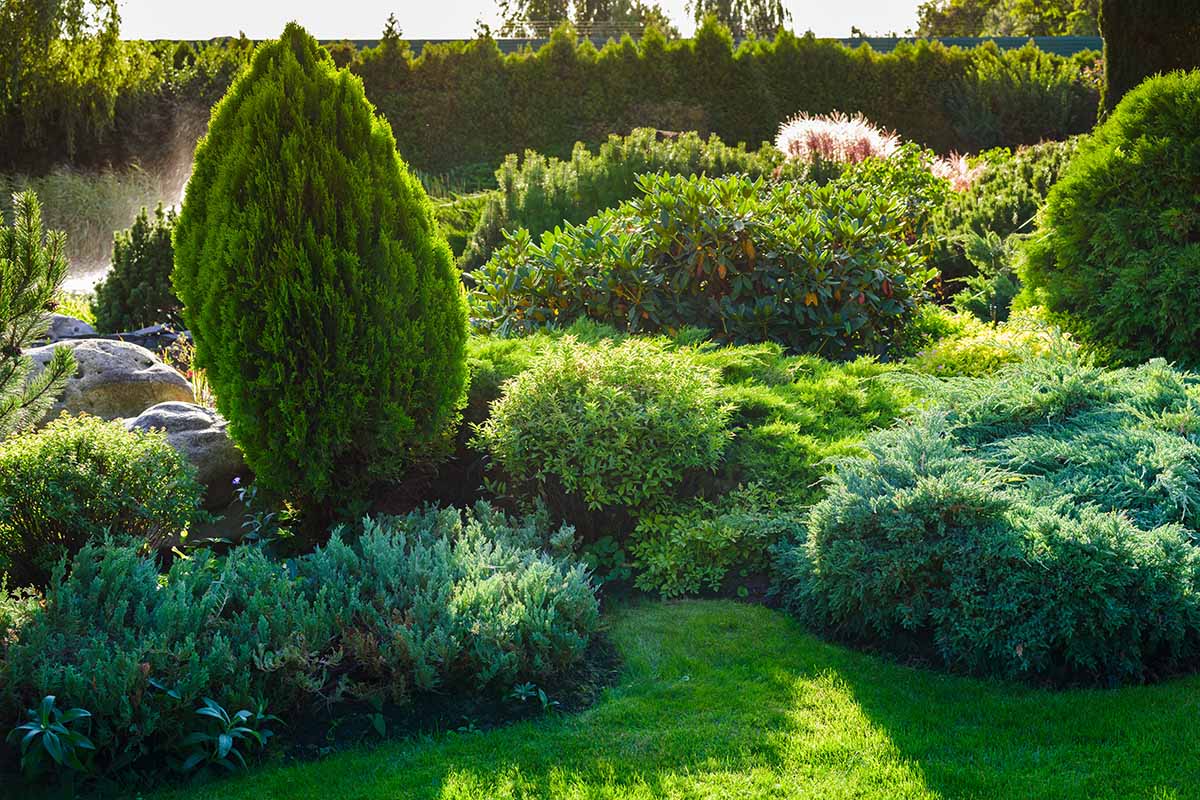
With the tips offered here, you can help your evergreen shrubs to make it through the toughest season of the year, sans injury. Winter injury, that is. A force majeure such as a lightning strike or shrub-shearing sleepwalk could still occur, I suppose…
Have remarks or questions to share? The comments section awaits.
To protect other plants in the garden from the damages of wintry weather, you’re sure to find these guides quite insightful:
